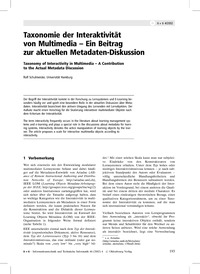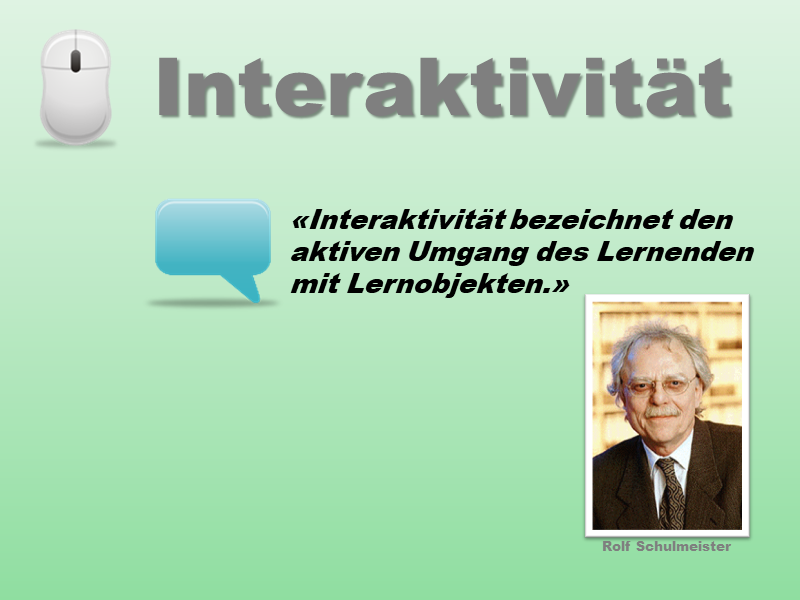Taxonomie der Interaktivität von MultimediaEin Beitrag zur aktuellen Metadaten-Diskussion
Erstpublikation in: it+ti, Ausgabe 4 (2002), Seite 193-199
Publikationsdatum:
|
 |
 Diese Seite wurde seit 1 Jahr inhaltlich nicht mehr aktualisiert.
Unter Umständen ist sie nicht mehr aktuell.
Diese Seite wurde seit 1 Jahr inhaltlich nicht mehr aktualisiert.
Unter Umständen ist sie nicht mehr aktuell.
 Zusammenfassungen
Zusammenfassungen
 Der Begriff der Interaktivität kommt in der Forschung zu Lernsystemen und E-Learning besonders häufig vor und spielt eine besondere Rolle in der aktuellen Diskussion über Metadaten. Interaktivität bezeichnet den aktiven Umgang des Lernenden mit Lernobjekten. Der Aufsatz macht einen Vorschlag für die Skalierung interaktiver multimedialer Objekte nach dem Kriterium der Interaktivität.
Der Begriff der Interaktivität kommt in der Forschung zu Lernsystemen und E-Learning besonders häufig vor und spielt eine besondere Rolle in der aktuellen Diskussion über Metadaten. Interaktivität bezeichnet den aktiven Umgang des Lernenden mit Lernobjekten. Der Aufsatz macht einen Vorschlag für die Skalierung interaktiver multimedialer Objekte nach dem Kriterium der Interaktivität. When it comes to creating the metadata on any kind of (learning) object, the types of the metadata items must be succintly defined. Schulmeister addresses metadata standards such as European Ariadne standard or IEEE’s LOM standard, and focuses on the metadata item of human-computer interactivity of multimedia components as found in interactive learning environments. The standards merely provide a scale from "very low" to "very high" interactivity. He argues that such a rating depends too much on the subjective viewpoints of the metadata author, and in this paper outlines a qualitative framework of interactivity categories that can be applied to multimedia components such as diagrams, animations, or Java applets.
When it comes to creating the metadata on any kind of (learning) object, the types of the metadata items must be succintly defined. Schulmeister addresses metadata standards such as European Ariadne standard or IEEE’s LOM standard, and focuses on the metadata item of human-computer interactivity of multimedia components as found in interactive learning environments. The standards merely provide a scale from "very low" to "very high" interactivity. He argues that such a rating depends too much on the subjective viewpoints of the metadata author, and in this paper outlines a qualitative framework of interactivity categories that can be applied to multimedia components such as diagrams, animations, or Java applets.
Schulmeister’s basic definition of interactivity is the amount of freedom of action users have in using the multimedia component. His model of interactivity defines six levels of increasing human-computer interaction. Level one means no interaction at all, but only a display of information, that is, there is no interaction on this level. Level two lets users navigate through the representation of information, choosing which links to follow. Level three offers multiple representations of the same content. Even on this level, there is hardly any interaction, but it provides the user with a choice of representation. On level four, the user can modify parameters of the representation. For example, in a 3d view, the user could move and rotate the object or adjust the lightning as needed. Additionally, on level five, the user can manipulate the content itself. The content is pre-fabricated, and the user can modify it to experiment with it. Interactivity level six means the user can create and manipulate content objects and watch the system react. This level provides the users with the highest degree of freedom in interacting with the multimedia component.
This model of interactivity is easy to understand and has the advantage of clearly distinguishing the increasing levels of interaction, from manipulating the representation to manipulating the content itself. What is less clear is the distinction between multimedia component interaction and program component interaction that Schulmeister makes in the second part of the paper. The distinction seems artificial, the boundaries blurred: Multimedia components can be regarded as special instances of program components. The article closes with a call to investigate the often-heard hypothesis that higher levels of interactivity have a positive effect on learning efficiency and learning results. [from http://www.elearning-reviews.org/topics/technology/interactive-environments/2003-schulmeister-interactivity-taxonomy/]
 Dieser Text erwähnt ...
Dieser Text erwähnt ...
 Personen KB IB clear | Jerome S. Bruner , Rolf Schulmeister | ||||||||||||||||||
 Begriffe KB IB clear | Interaktivitätinteractivity
,  Lernen Lernen learning
, Lernsoftware
, LOM (Learning Objects Metadata)Learning Objects Metadata
, Metadatenmeta data
, learning
, Lernsoftware
, LOM (Learning Objects Metadata)Learning Objects Metadata
, Metadatenmeta data
,  Motivation Motivation motivation
, motivation
,  Multimedia Multimedia multimedia
, Taxonomietaxonomy
, multimedia
, Taxonomietaxonomy
,  Visualisierung Visualisierung visualization visualization
| ||||||||||||||||||
 Bücher |
|
 Tagcloud
Tagcloud
 Vorträge von Beat mit Bezug
Vorträge von Beat mit Bezug
 Zitationsgraph
Zitationsgraph
 Zitationsgraph (Beta-Test mit vis.js)
Zitationsgraph (Beta-Test mit vis.js)
 Zeitleiste
Zeitleiste
 24 Erwähnungen
24 Erwähnungen 
- eLearning in Notebook-Klassen - Empirisch-didaktische Begleituntersuchung (Erwin Bratengeyer, Gerda Kysela-Schiemer) (2002)


- Lernplattformen für das virtuelle Lernen - Evaluation und Didaktik (Rolf Schulmeister) (2003)


- Digitaler Campus - Vom Medienprojekt zum nachhaltigen Medieneinsatz in der Hochschule (Michael Kerres, Britta Voß) (2003)


- Entdeckendes Lernen als didaktisches Konzept in einem interdisziplinären Lehr-Lernprogramm zur Statistik (Robert Gücker, Klaus Nuyken, Burkhard Vollmers)

- Vom Seminar zur Online-Lerneinheit - und zurück

- Entdeckendes Lernen als didaktisches Konzept in einem interdisziplinären Lehr-Lernprogramm zur Statistik (Robert Gücker, Klaus Nuyken, Burkhard Vollmers)
- On the Learning in E-Learning (Raimond Reichert, Werner Hartmann) (2004)


- E-Learning in Hochschulen und Bildungszentren - Gestaltungshinweise für pädagogische Innovationen (Dieter Euler, Sabine Seufert) (2004)


- Campus 2004 - Kommen die digitalen Medien an den Hochschulen in die Jahre? (Doris Carstensen, Beate Barrios) (2004)


- Exorciser - Automatic Generation and Interactive Grading of Structured Exercises in the Theory of Computation (Vincent Tscherter) (2004)



- 2. Interactive Exercises - Examples
- Ad Fontes - Zu Konzept, Realisierung und Nutzung eines E-Learning-Angebots (Andreas Kränzle, Gerold Ritter) (2004)

- GraphBench - Exploring the Limits of Complexity with Educational Software (ETH Dissertation 16392) (Markus Brändle) (2006)


- Das 4-Schritte-Modell - Grundlage für ein kompetenzorientiertes E-Learning (Lukas Emanuel Fässler) (2007)


- Interactive Learning Environments for Mathematical Topics (Ruedi Arnold) (2007)


- LogicTraffic - Logik in der Allgemeinbildung (Ruedi Arnold, Werner Hartmann) (2007)

- InfoTraffic - Teaching Important Concepts of Computer Science and Math through Real-World Examples (Ruedi Arnold, Marc Langheinrich, Werner Hartmann) (2007)


- INFOS 2007 - Didaktik der Informatik in Theorie und Praxis - 12. GI-Fachtagung Informatik und Schule (Sigrid E. Schubert) (2007)
- Fachdidaktische Diskussion von Informatiksystemen und der Kompetenzentwicklung im Informatikunterricht (Peer Stechert) (2009)


- INFOS 2009 - 13. GI-Fachtagung Informatik und Schule (21. - 24. September 2009 in Berlin) (Bernhard Koerber) (2009)


- Programming-Wiki - Online Programmieren und Kommentieren (Michael Hielscher, Christian Wagenknecht)

- Programming-Wiki - Online Programmieren und Kommentieren (Michael Hielscher, Christian Wagenknecht)
- Studientext Didaktisches Design (Gabi Reinmann) (2010)


- Autorenwerkzeuge für digitale, multimediale und interaktive Lernbausteine im Web 2.0 (Michael Hielscher) (2013)



- Das elektronische Schulbuch (2014) - Fachdidaktische Anforderungen und Ideen treffen auf Lösungsvorschläge der Informatik (Michael Schuhen, Manuel Froitzheim) (2014)

- Vorschlag einer Interaktivitätstaxonomie zur Klassifizierung von Aufgaben (Manuel Froitzheim, Michael Schuhen)

- Vorschlag einer Interaktivitätstaxonomie zur Klassifizierung von Aufgaben (Manuel Froitzheim, Michael Schuhen)
- Bildung gemeinsam verändern - Diskussionsbeiträge und Impulse aus Forschung und Praxis (Harald Eichelberger, David Meinhard, Valentin Dander, Andrea Lißner, Christoph Rensing, Klaus Rummler, Timo van Treeck) (2017)
- Anforderungen an ein elektronisches Schulbuch der Zukunft (Manuel Froitzheim)


- Anforderungen an ein elektronisches Schulbuch der Zukunft (Manuel Froitzheim)
- Lehrmittel in einer digitalen Welt (Beat Döbeli Honegger, Michael Hielscher, Werner Hartmann) (2018)



- Entwicklung und langfristige Wartung interaktiver Lernumgebungen für den Informatikunterricht - Arbeitsbericht April 2021 (Michael Hielscher, Ruedi Arnold, Werner Hartmann) (2021)


- Schulbücher und digitale Lernplattformen - Eine vergleichende Analyse von Aufgaben hinsichtlich kognitiver Aktivierung und Visualisierungen (Daniel Thurm, Bärbel Barzel, Andreas Büchter) (2024)


 Volltext dieses Dokuments
Volltext dieses Dokuments
 |  Taxonomie der Interaktivität von Multimedia: Artikel als Volltext ( Taxonomie der Interaktivität von Multimedia: Artikel als Volltext ( : :  , 221 kByte; , 221 kByte;  : :  Link unterbrochen? Letzte Überprüfung: 2021-03-21 Letzte erfolgreiche Überprüfung: 2015-05-28) Link unterbrochen? Letzte Überprüfung: 2021-03-21 Letzte erfolgreiche Überprüfung: 2015-05-28) |
 Anderswo suchen
Anderswo suchen 
 Beat und dieser Text
Beat und dieser Text
Beat war Co-Leiter des ICT-Kompetenzzentrums TOP während er Dieser Text ins Biblionetz aufgenommen hat. Die bisher letzte Bearbeitung erfolgte während seiner Zeit am Institut für Medien und Schule. Beat besitzt kein physisches, aber ein digitales Exemplar. Eine digitale Version ist auf dem Internet verfügbar (s.o.). Beat hat Dieser Text auch schon in Vorträgen erwähnt.










 Biblionetz-History
Biblionetz-History